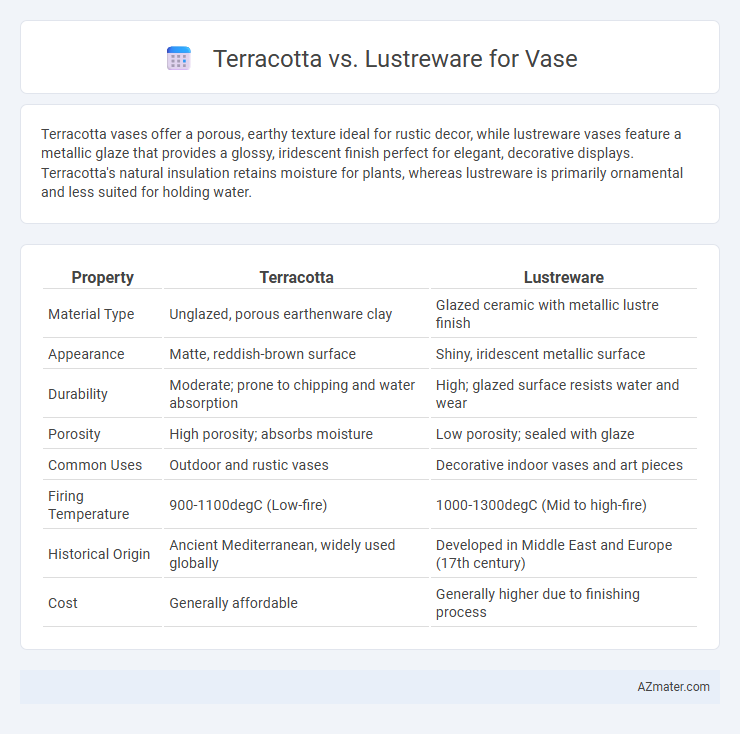Terracotta vases offer a porous, earthy texture ideal for rustic decor, while lustreware vases feature a metallic glaze that provides a glossy, iridescent finish perfect for elegant, decorative displays. Terracotta's natural insulation retains moisture for plants, whereas lustreware is primarily ornamental and less suited for holding water.
Table of Comparison
| Property | Terracotta | Lustreware |
|---|---|---|
| Material Type | Unglazed, porous earthenware clay | Glazed ceramic with metallic lustre finish |
| Appearance | Matte, reddish-brown surface | Shiny, iridescent metallic surface |
| Durability | Moderate; prone to chipping and water absorption | High; glazed surface resists water and wear |
| Porosity | High porosity; absorbs moisture | Low porosity; sealed with glaze |
| Common Uses | Outdoor and rustic vases | Decorative indoor vases and art pieces |
| Firing Temperature | 900-1100degC (Low-fire) | 1000-1300degC (Mid to high-fire) |
| Historical Origin | Ancient Mediterranean, widely used globally | Developed in Middle East and Europe (17th century) |
| Cost | Generally affordable | Generally higher due to finishing process |
Introduction to Vase Materials
Terracotta and lustreware represent distinct materials used in vase crafting, each offering unique aesthetic and functional qualities. Terracotta, a porous clay fired at low temperatures, provides a rustic, earthy texture ideal for outdoor and traditional decor. Lustreware, characterized by its iridescent glaze achieved through metallic oxide finishes, adds a reflective, glossy surface favored in decorative and high-end interior settings.
What is Terracotta?
Terracotta is a type of earthenware clay known for its porous, reddish-brown finish after firing, making it a popular material for decorative and functional vases. Unlike Lustreware, which features a metallic glaze that gives a shiny, reflective surface, terracotta vases are unglazed or have a matte finish that highlights their natural texture. The breathable quality of terracotta makes it ideal for plant vases, as it allows air and moisture to pass through, promoting healthier root growth.
What is Lustreware?
Lustreware is a type of pottery characterized by its iridescent metallic glaze, created by applying a thin layer of metal oxides to the surface that reflects light in shimmering colors. Unlike terracotta, which is an unglazed, porous clay material typically reddish-brown and known for its rustic and earthy appearance, lustreware focuses on decorative brilliance and delicate finishes. This technique was popularized in Islamic pottery and later in European ceramics, making lustreware vases prized for their glossy, reflective sheen and intricate artistry.
Historical Significance of Terracotta Vases
Terracotta vases hold immense historical significance, dating back to ancient civilizations like Mesopotamia, Greece, and Rome, where they were essential for daily use, storage, and ceremonial purposes. Unlike lustreware, which emerged during the Islamic Golden Age and is prized for its iridescent metallic glaze, terracotta vases offer insight into early pottery techniques and horticultural practices through their natural, unglazed clay composition. These vessels serve as valuable archaeological artifacts that reveal cultural rituals, trade, and artistic evolution over millennia.
Historical Significance of Lustreware Vases
Lustreware vases hold significant historical value, originating in the medieval Islamic world and later gaining popularity in Renaissance Europe, showcasing advanced glazing techniques that produce an iridescent metallic sheen. Unlike terracotta, which is valued for its earthy texture and widespread use since ancient times, lustreware represents a sophisticated technological and artistic development in ceramic history. These vases often served as luxury items and status symbols, reflecting cultural exchanges along trade routes and evolving craftsmanship.
Key Differences: Terracotta vs Lustreware
Terracotta vases are made from porous, earthen clay that is fired at low temperatures, resulting in a rustic, matte finish ideal for a natural and earthy aesthetic. Lustreware vases, in contrast, feature a metallic glaze created by applying a thin layer of metal oxide, producing an iridescent, glossy surface with reflective qualities. The key differences between terracotta and lustreware vases lie in their material composition, firing technique, and surface appearance, with terracotta emphasizing durability and organic texture while lustreware focuses on decorative shine and intricate finishes.
Aesthetic Appeal and Design Comparisons
Terracotta vases offer a warm, earthy aesthetic with a matte, porous texture that highlights natural clay tones, making them ideal for rustic or traditional decor styles. Lustreware vases feature a glossy, iridescent finish achieved through a metallic glaze, creating a vibrant and reflective surface that enhances contemporary or decorative interiors. The design of terracotta emphasizes simplicity and organic forms, while lustreware showcases intricate patterns and vivid colors, providing a striking contrast in visual appeal and artistic expression.
Durability and Maintenance
Terracotta vases are porous and prone to chipping, requiring sealing to improve durability and prevent water absorption, while lustreware vases feature a metallic glaze that offers enhanced resistance to scratches and stains. Maintenance for terracotta involves careful cleaning and periodic resealing to avoid deterioration, whereas lustreware demands gentle cleaning to preserve its lustrous finish without abrasive materials. Choosing between them depends on the vase's intended use, with terracotta suited for rustic outdoor settings and lustreware ideal for decorative indoor displays.
Best Uses for Each Material
Terracotta vases excel in outdoor gardening due to their porous nature, which promotes aeration and moisture regulation for plants. Lustreware vases, with their glazed, reflective surface, are best suited for decorative indoor displays where their vibrant, iridescent finish enhances aesthetic appeal. Choosing terracotta is ideal for rustic, natural decor and plant health, whereas lustreware complements elegant, colorful interior settings.
Choosing the Right Vase Material for Your Space
Terracotta vases offer a rustic, porous texture ideal for plants that require good aeration and drainage, while lustreware vases provide a glossy, reflective finish that adds a sophisticated, decorative touch to modern interiors. Choosing terracotta enhances natural, earthy aesthetics and is perfect for outdoor or casual spaces, whereas lustreware suits elegant, formal settings with its vibrant, iridescent glaze. Consider the environment and style of your space: terracotta is durable and breathable for practical use, while lustreware prioritizes visual appeal with a delicate, showpiece quality.

Infographic: Terracotta vs Lustreware for Vase
 azmater.com
azmater.com